throttle valve HONDA INTEGRA 1998 4.G Owner's Guide
[x] Cancel search | Manufacturer: HONDA, Model Year: 1998, Model line: INTEGRA, Model: HONDA INTEGRA 1998 4.GPages: 1681, PDF Size: 54.22 MB
Page 460 of 1681
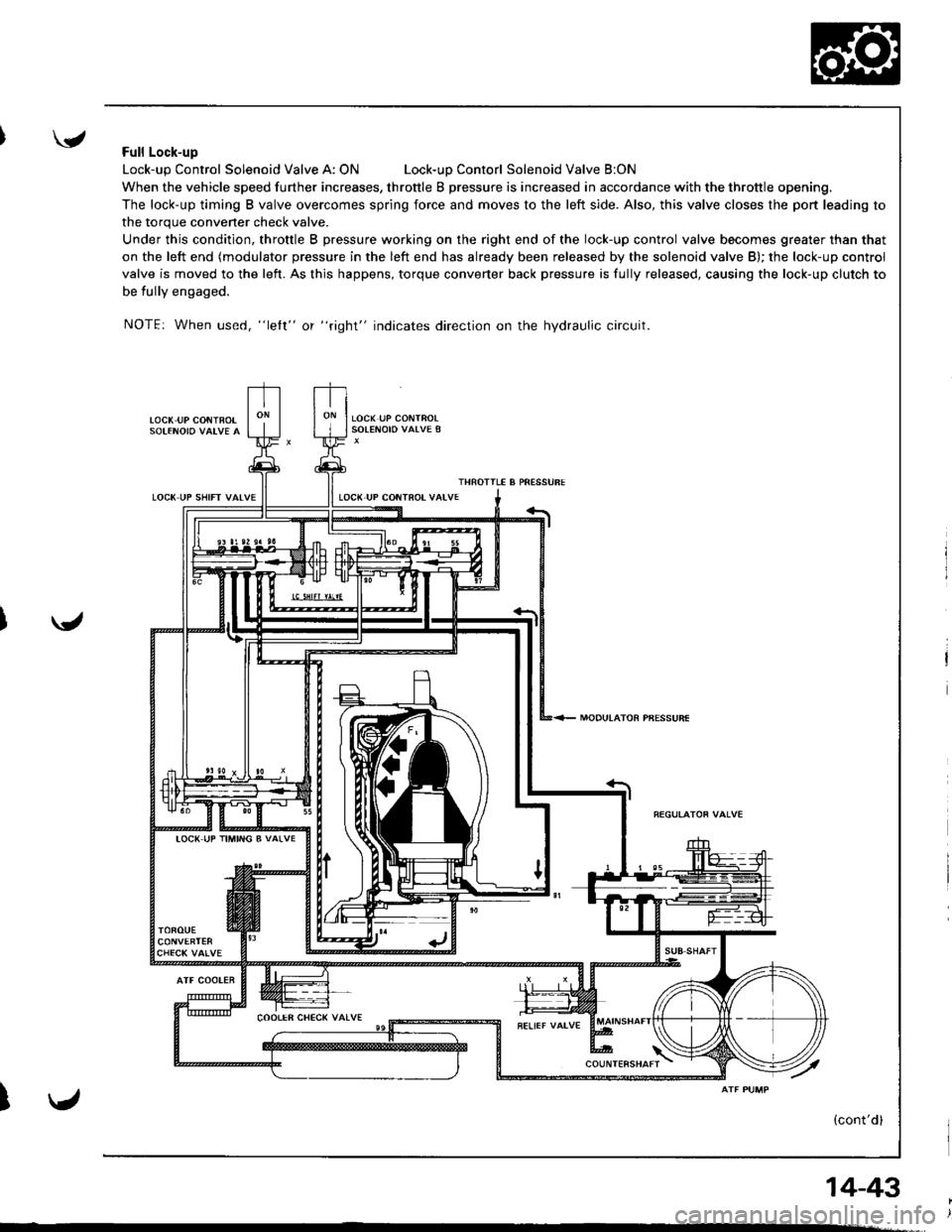
'Full Lock-up
Lock-up Control Solenoid Valve A: ONLock-uD Contorl Solenoid Valve B:ON
When the vehicle speed further increases, throttle B pressure is increased in accordance with the throttle opening.
The lock-up timing B valve overcomes spring force and moves to the left side. Also, this valve closes the port leading to
the torque convener check valve.
Under this condition, throttle B pressure working on the right end of the lock-up control valve becomes greater than that
on the left end (modulator pressure in the left end has already been released by the solenoid valve B); the lock-up control
valve is moved to the left. As this happens, torque converter back pressure is fully released, causing the lock-up clutch to
be tully engaged.
NOTE: When used, "lelt" or "right" indicates direction on the hydraulic circuit.
LOC( UP CONiBOT
LOCK UP SHIFT VAIVE
MODULATOR PBESSURE
ATF COOLER
I
IOC( UP TIMING B VALVE
14-43
Page 462 of 1681

Component Locations
"/,4
'JJ-N
{7v
A0t
\ /
t
AUTOMATIC TRANSAXLE IAiTIGEAR POSITION SWITCH
VEHICLE SPEEDSENSOR {VSSt
COUNTERSHAFTSPEED SENSORMAINSHAFT SPEEDSENSORTHROTTLE POSITIOT{ {TPI
e
SHIFT CONTROLSOLENOID VALVE A/BASSEMBLY
I
- ::::i ---l
1445
Page 471 of 1681
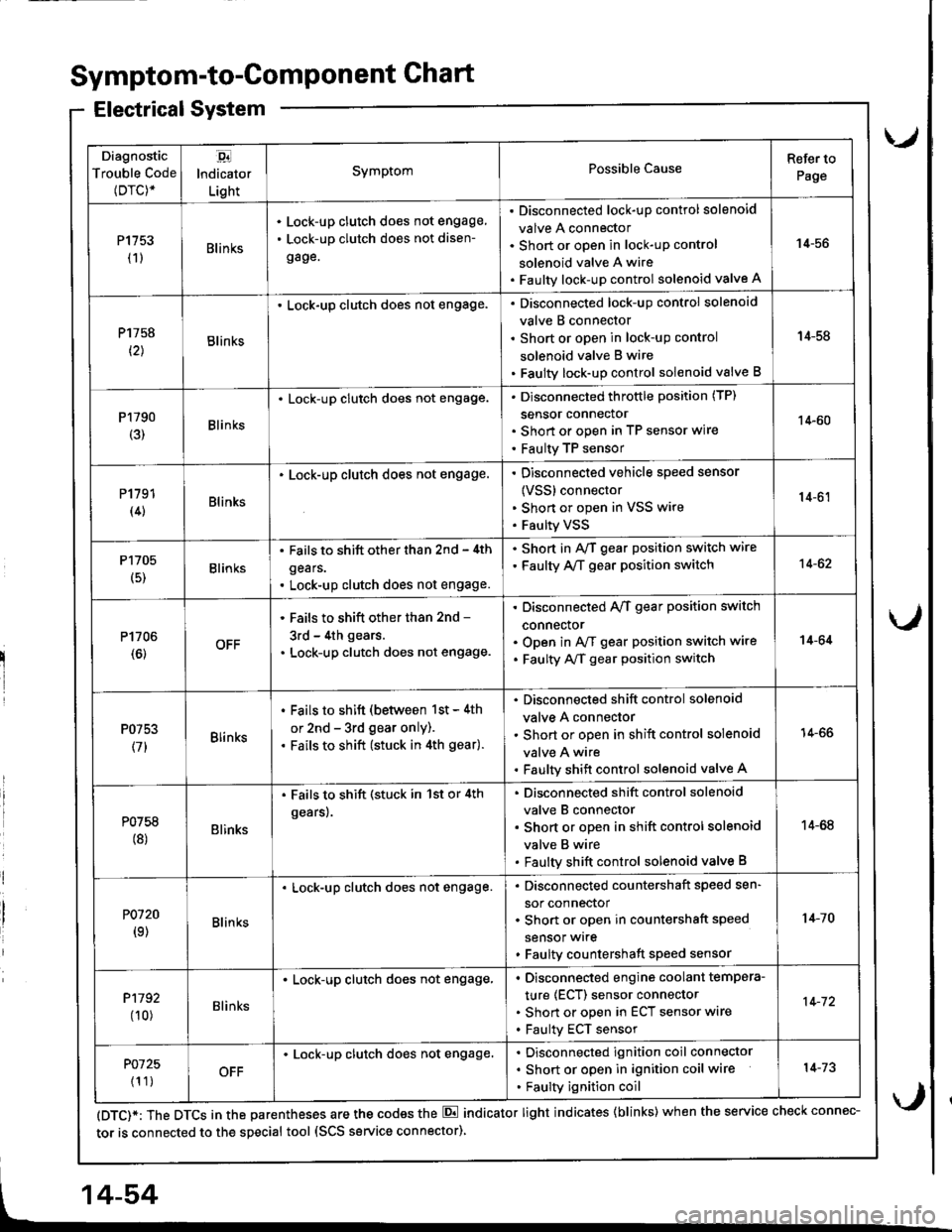
Diagnostic
Trouble Code(Drc)*
,94
lndicator
Light
SymptomPossible CauseRefer to
Page
P1153(1)Blin ks
Lock-up clutch does not engage,
Lock-up clutch does not disen-
gage.
Disconnected lock-up control solenoid
valve A connector
Short or open in lock-uP control
solenoid valve A wire
Faulty lock-up control solenoid valve A
14-56
P1758
t2lBlinks
. Lock-up clutch does not engage.Disconnected lock-up control solenoid
valve B connector
Short or open in lock-uP control
solenoid valve B wire
Faulty lock-up control solenoid valve B
14-58
P1790(3)Blinks
. Lock-up clutch does not engage.Disconnected throttle position (TP)
sensor connector
Short or open in TP seflsor wire
Faulty TP sensor
14-60
P1191(4)Blinks
. Lock-up clutch does not engage.Disconnected vehicle speed sensor
{VSS} connector
Shon or open in VSS wire
Faulty VSS
14-61
P1705
(5)Blinks
. Fails to shift other than 2nd - 4th
gears.
. Lock-up clutch does not engage.
. Shod in AvT gear position switch wire
. Faulty A,/T gear position switch14-62
P1706(6)OFF
' Fails to shift other than 2nd -
3rd - 4th gears.
. Lock-up clutch does not engage.
Disconnected A/T gear position switch
connector
Open in A/f gear position switch wire
Faulty A/f gear position switch
14-64
P0753
(71Blinks
. Fails to shift (between 1st - 4th
or 2nd - 3rd gear only).. Fails to shift (stuck in 4th gear).
Disconnected shift control solenoid
valve A connector
Short or open in shift control solenoid
valve A wire
Faulty shift control solenoid valve A
14-66
P0758(8)Blinks
. Fails to shift (stuck in 1st or 4th
gears).
Disconnected shift control solenoid
valve B connector
Short or open in shift control solenoid
valve B wire
Faulty shift control solenoid valve B
14-68
P0120(9)Blin ks
Lock-up clutch does not engage.Disconnected countershaft speed sen-
sor connector
Short or open in countershaft speed
sensor wrre
Faulty countershaft speed sensor
1+10
P1192
00)Blinks
. Lock-up clutch does not engage,Disconnected engine coolant tempera-
ture (ECT) sensor connector
Short or open in ECT sensor wire
Faulty ECT sensor
14-72
P0725
{1 1)OFF
Lock-up clutch does not engage.Disconnected ignition coil connector
Short or open in ignition coil wire
Faulty ignition coil
14-73
Symptom-to-ComPonent Chart
Electrical System
(DTC)*: The DTCS in the parentheses are the codes the E indicator light indicates {blinks) when the service check connec-
tor is connected to the special tool (SCS service connector)
4-54
Page 508 of 1681
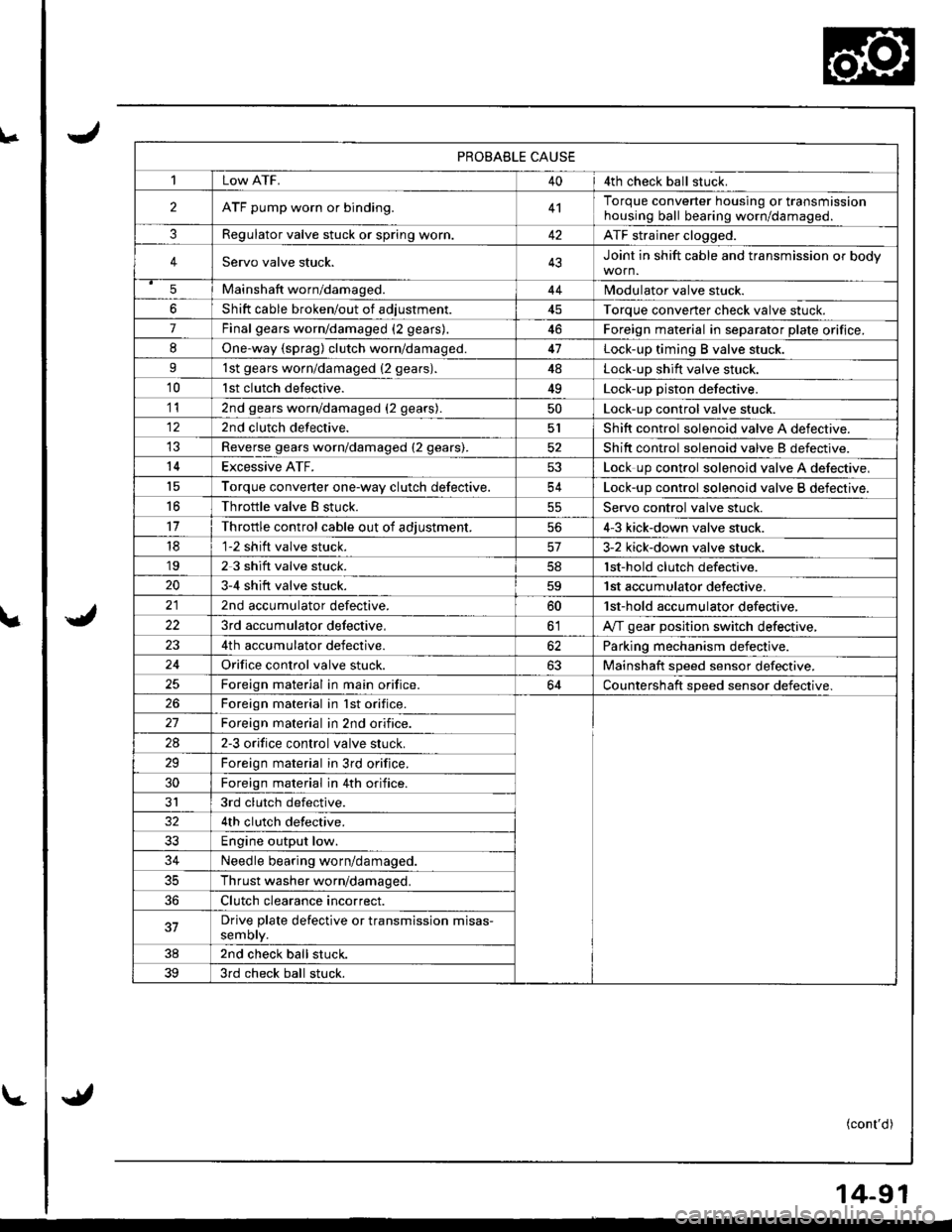
L
\a
\."tl
14-91
J
al
PROBABLE CAUSE
1Low ATF.404th check ball stuck.
2ATF pump worn or binding.4'lTorque converter housing or transmissionhousing ball bearing worn/damageo.
3Regulator valve stuck or spring worr..42ATF strainer clogged.
4Servo valve stuck.43Joint in shift cable and transmission or body
5Mainshaft worn/damaged.44Modulator valve stuck.
6Shift cable broken/out of adiustment45Torque converter check valve stuck.
7Final gears worn/damaged (2 gears).46Foreign material in separator plate orifice.
8One.way {sprag) clutch worn/damaged.47Lock-up timing B valve stuck.
91st gears worn/damaged {2 gears).4ALock-up shift valve stuck.
10lst clutch defective.49Lock-up piston defective.
112nd gears worn/damaged (2 gears).50Lock-up control valve stuck.
122nd clutch defective.5lShift control solenoid valve A defective.
Reverse gears worn/damaged (2 gears).52Shift control solenoid valve B defectrve.
14Excessive ATF.53Lock up control solenoid valve A defective,'t5Torque converter one-wav clutch defective.54Lock-up control solenoid valve B defective.
16Throttle valve B stuck.55Servo control valve stuck.
11Throttle control cable out of adiustment.564-3 kick-down valve stuck.
181-2 shift valve stuck.3-2 kick-down valve stuck.'192 3 shift valve stuck.lst-hold clutch defective.
203-4 shift valve stuck.59'| st accumulator defective.
2nd accumulator defective.60'lst-hold accumulator defective,
223rd accumulator delective,olA,rf gear position switch defective,
4th accumulator defective.62Parking mechanism defective.
24Orifice control valve stuck.63Mainshaft speed sensor defective.
Foreign material in main orifice.64Countershaft speed sensor defective.
26Foreign material in lst orifice.
Foreign material in 2nd orifice.
2A2-3 orifice control valve stuck.
29Foreign material in 3rd orifice.
30Foreign material in 4th orifice.
JI3rd clutch defective.
4th clutch defective.
33Engine output low.
34Needle bearing worn/damaged.
35Thrust washer worn/damaged.
36Clutch clearance incorrect.
37Drive plate defective or transmission misas-semory.
382nd check ball stuck.
393rd check ball stuck.
(cont'd)
Page 510 of 1681
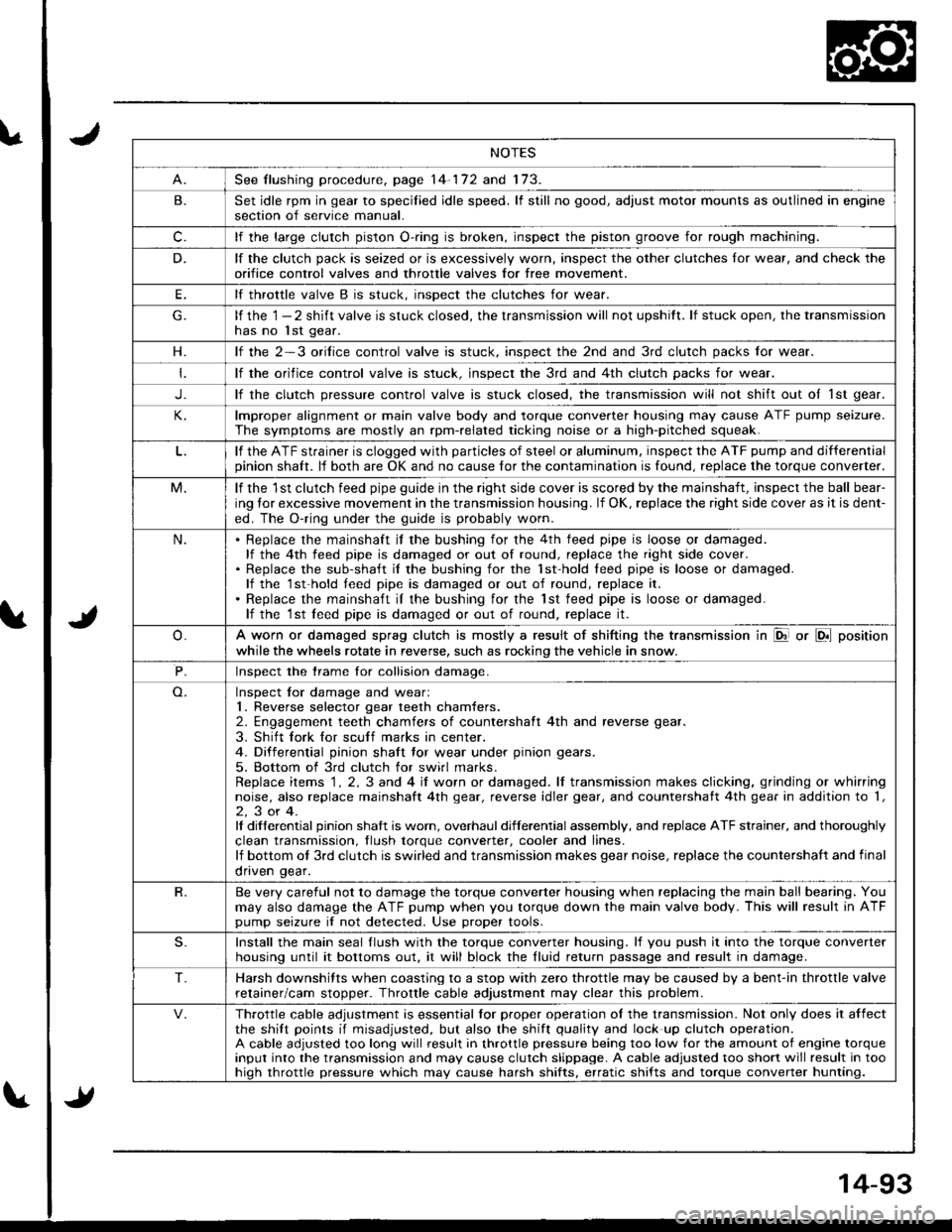
NOTES
See flushing procedure, page 14-172 and 173.
B.Set idle rpm in gear to specilied idle speed. lf still no good, adjust motor mounts as outlined in enginesection of service manual.
c.lf the large clutch piston O-.ing is broken, inspect the piston groove for rough machining.
D.lf the clutch pack is seized or is excessively worn, inspect the other clutches lor wear, and check the
orifice control valves and throttle valves for free mov€ment.
E.lf throttle valve B is stuck. insDect the clutches for wear.
lf the 1 - 2 shift valve is stuck closed, the transmission will not upshitt. lf stuck open, the transmissionhas no lst gear.
H.lf the 2-3 orilice control valve is stuck, inspect the 2nd and 3rd clutch packs for wear.
lf the orifice control valve is stuck. inspect the 3rd and 4th clutch packs for wear.
J.lf the clutch pressure control valve is stuck closed, the transmission will not shift out oI 1st gear.
lmproper alignment or main valve body and torque converter housing may cause ATF pump seizure.
The symptoms are mostly an rpm-related ticking noise or a high-pitched squeak.
lf the ATF strainer is clogged with particles of steel or aluminum, inspect the ATF pump and differentialpinion shaft. lf both are OK and no cause for the contamination is found, replace the torque converter.
M.lf the 1st clutch feed pipe guide in the right side cover is scored by the mainshaft, inspect the ball bear-
ing lor excessive movement in the transmission housing. lf OK, replace the right side cover as it is dent-
ed. The O-ring under the guide is probably worn.
N.Replace the mainshaft if the bushing for the 4th feed pipe is loose or damaged.lf the 4th feed pipe is damaged or out of round, replace the right side cover.Replace the sub-shaft il the bushing for the 1st-hold teed pipe is loose or damaged.lf the 1st-hold teed pipe is damaged or out of round, replace it.
Replace the mainshaft iI the bushing for the lst feed pipe is loose or damaged.lf the 1st leed pipe is damaged or out of round, replace it.
A worn or damaged sprag clutch is mostly a result of shifting the transmission in El or LDll position
while the wheels rotate in reverse, such as rocking the vehicle in snow.
P.Inspect the trame for collision damage.
Inspect lor damage and wear:1. Reverse selector gear teeth chamfers.2. Engagement teeth chamfers of countershaft 4th and reverse gear.
3. Shift fork for scuff marks in center.4. Differential pinion shaft tor wear under pinion gears.
5. Bottom of 3rd clutch for swirl marks.Replace items 1 . 2, 3 and 4 iI worn or damaged. lf transmission makes clicking, grinding or whirringnoise, also replace mainshaft 4th gear, reverse idler gear, and countershatt 4th gear in addition to '1,
2,3or4.It differential pinion shalt is worn, overhaul differential assembly, and replace ATF strainer, and thoroughly
clean transmission, tlush torque conveder, cooler and lines.lf bottom ot 3rd clutch is swirled and transmission makes gear noise, replace the countershaft and final
onven qear.
R.Be very careful not to damage the torque converter housing when replacing the main ball bearing. You
may also damage the ATF pump when you torque down the main valve body. This will result in ATFpump seizure if not detected. Use proper tools.
S.Install the main seal llush with the torque converter housing. lf you push it into the torque converterhousing until it bottoms out. it will block the fluid return passage and result in damage.
T.Harsh downshifts when coasting to a stop with zero throttle may be caused by a bent-in throttle valve
retainer/cam stopper. Throttle cable adjustment may clear this problem.
Throttle cable adjustment is essential tor proper operation ol the transmission. Not only does it affectthe shift points if misadjusted, but also the shift quality and lock up clutch operation.A cable adjusted too long will result in throttle pressure being too low for the amount of engine torqueinput into the transmission and may cause clutch slippage. A cable adjusted too short will result in toohiqh throttle pressure which may cause harsh shifts, erratic shifts and torque converter hunting.
Page 513 of 1681
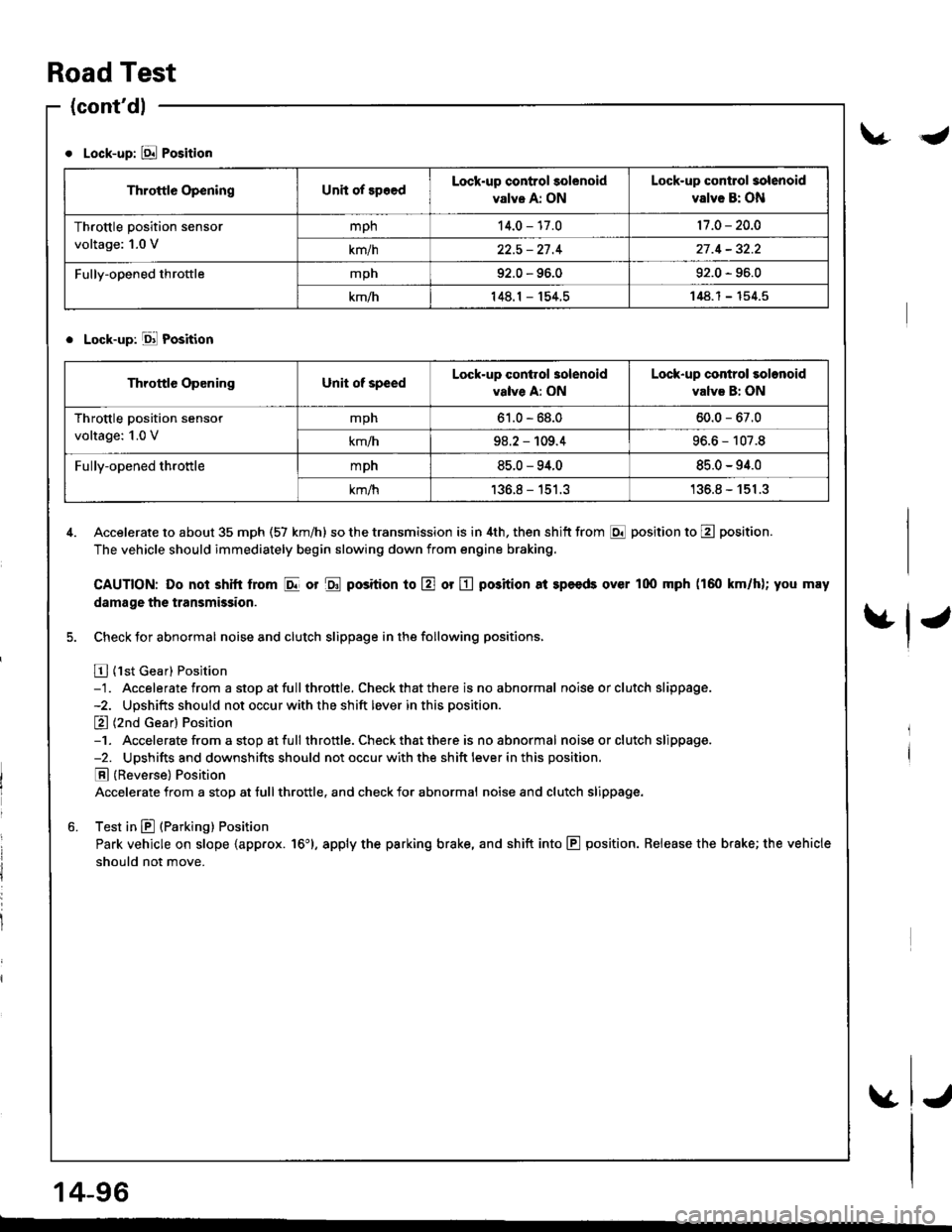
Road Test
(cont'dl
Lock-up: E Position
. Lock-up: Ell Position
4. Accelerate to about 35 mph (57 km/h) so the transmission is in 4th, then shitt from E position to E position.
The vehicle should immediately begin slowing down from engine braking.
CAUTION: Do noi shitt lrom I or $ position to E or E position 8t speeds over l0o mph (160 km/h); you may
damage the transmission.
5. Check for abnormal noise and clutch slippage in the following positions,
E {1st Gear} Position-1. Accelerate from a stop at fullthrottle. Check that there is no abnormal noise or clutch slippage.-2. Upshifts should not occur with the shift lever in this position.
E (2nd Gear) Position-1. Accelerate from a stop atfull throttle. Check that there is noabnormal noiseorclutch slippage.-2. Upshifts and downshifts should not occur with the shift lever in this position.
E (Reverse) Position
Accelerate from a stop at tull throttle, and check for abnormal noise and clutch slippage.
6. Test in E (Parking) Position
Park vehicle on slope {app.ox. 16'}, apply the parking brake, and shift into E position. Release the brake; the vehicle
should not move.
Throttle OpeningUnit of spoedLock-up control solenoid
valve A: ON
Lock-up contlol solenoid
valve B: ON
Throttle position sensor
voltage: 1.0 V
mph14.0 - 17.017 .0 - 20.0
km/h22.5 - 27 .427 .4 - 32.2
Fully-opened throftlemph92.0 - 96.092.0 - 96.0
km/h148.1 - 154.5148.1- 154.5
Throttle OpeningUnit of speedLock-up conirol 3olenoid
valve A: ON
Lock-up control solonoid
valvs B: ON
Throttle position sensor
voltage: 1.0 V
mph61.0 - 68.060.0 - 67.0
km/h98.2 - 109.496.6 - 107.8
Fully-opened throttlempn85.0 - 94.085.0 - 94.0
km/h136.8 - 151.3'136.8 - 151.3
14-96
-
Page 516 of 1681
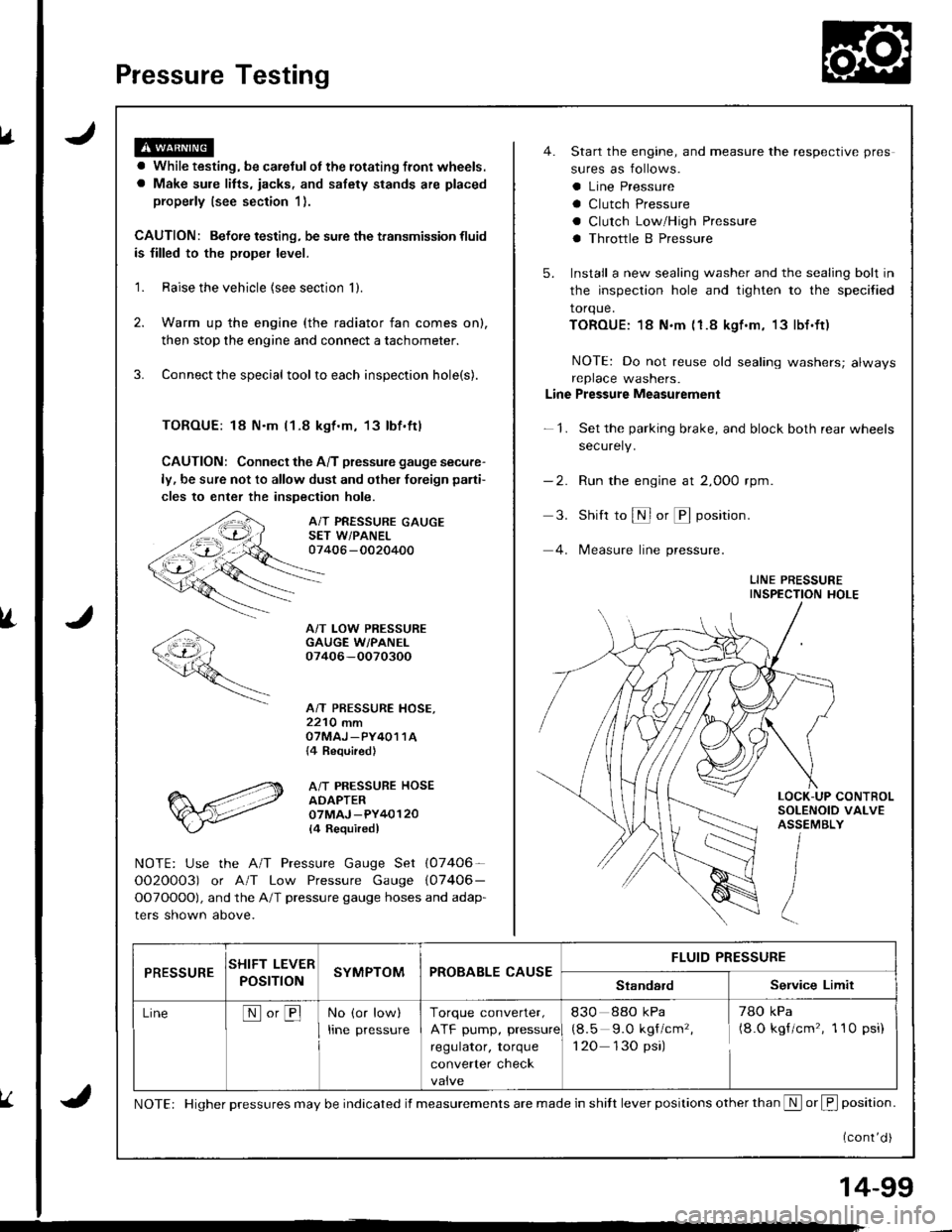
Pressure Testing
a While testing, be careJulot the rotating front wheels.
a Make sule litts, iacks, and safety stands are placed
properly (see section 1).
CAUTION: Befoie testing, be sure the transmission fluid
is filled to the proper level.
'1. Raise the vehicle {see section 'll.
2. Warm up the engine (the radiator fan comes on),
then stop the engine and connect a tachometer.
3. Connect the special tool to each inspection hole(s).
TOROUE: 18 N.m l1-8 kgt.m, 13lbf.ftl
CAUTION: Connect the A/T pressure gauge secure-
ly, be sure not to allow dust and olher foreign pani-
cles to enter the inspection hole.
A/T PRESSURE GAUGESET W/PANEL07406 -0020400
A/T LOW PRESSUREGAUGE W/PANEI.07406-OO70300
A/T PRESSURE HOSE,2210 mmOTMAJ _PY4O1 1A{4 Required}
A/T PRESSURE HOSEADAPTER07MAJ -PY40120
l4 Requiredl
NOTE: Use the A/T Pressure Gauge Set (07406-
OO2O0O3) or A/T Low Pressure Gauge (07406-
OOTOOOO), and the A/T pressure gauge hoses and adap-
ters shown above.
4. Start the engine, and measure the respective pres
sures as follows.
a Line Pressure
a Clutch Pressure
a Clutch Low/High Pressure
a Throttle B Pressure
5. Install a new sealing washer and the sealing bolt in
the inspection hole and tighten to the specified
torque.
TOROUE:18 N.m (1.8 kgf.m, 13lbf.ft)
NOTE: Do not reuse old sealing washers; alwaysreplace washers.
Line Pressure Measurement
-1. Set the parking brake, and block both rear wheels
securely.
-2. Run the engine at 2,000 rpm
3. Shift to S or @ position.
4. lMeasure line pressure.
LINE PRESSUREINSPECTION HOLE
LOCK-UP CONTROLSOLENOID VALVEASSEMBLY
PRESSURESHIFT LEVER
POST ONSYMPTOMPROBABLE CAUSEFLUID PRESSURE
StandardService Limit
LineNo,BNo (or low)
Irne pressure
Torque converter,
ATF pump, pressure
regulator, torque
converter check
830 88o kPa
(8.5 9.O kgf/cm'�,
1 20 130 psi)
78O kPa(8.O kgf/cm'�, 1 10 psi)
NOTE: Higher pressures may be indicated if measurements are made in shitt lever positions other than S or f, position.
{cont'd )
14-99
Page 517 of 1681
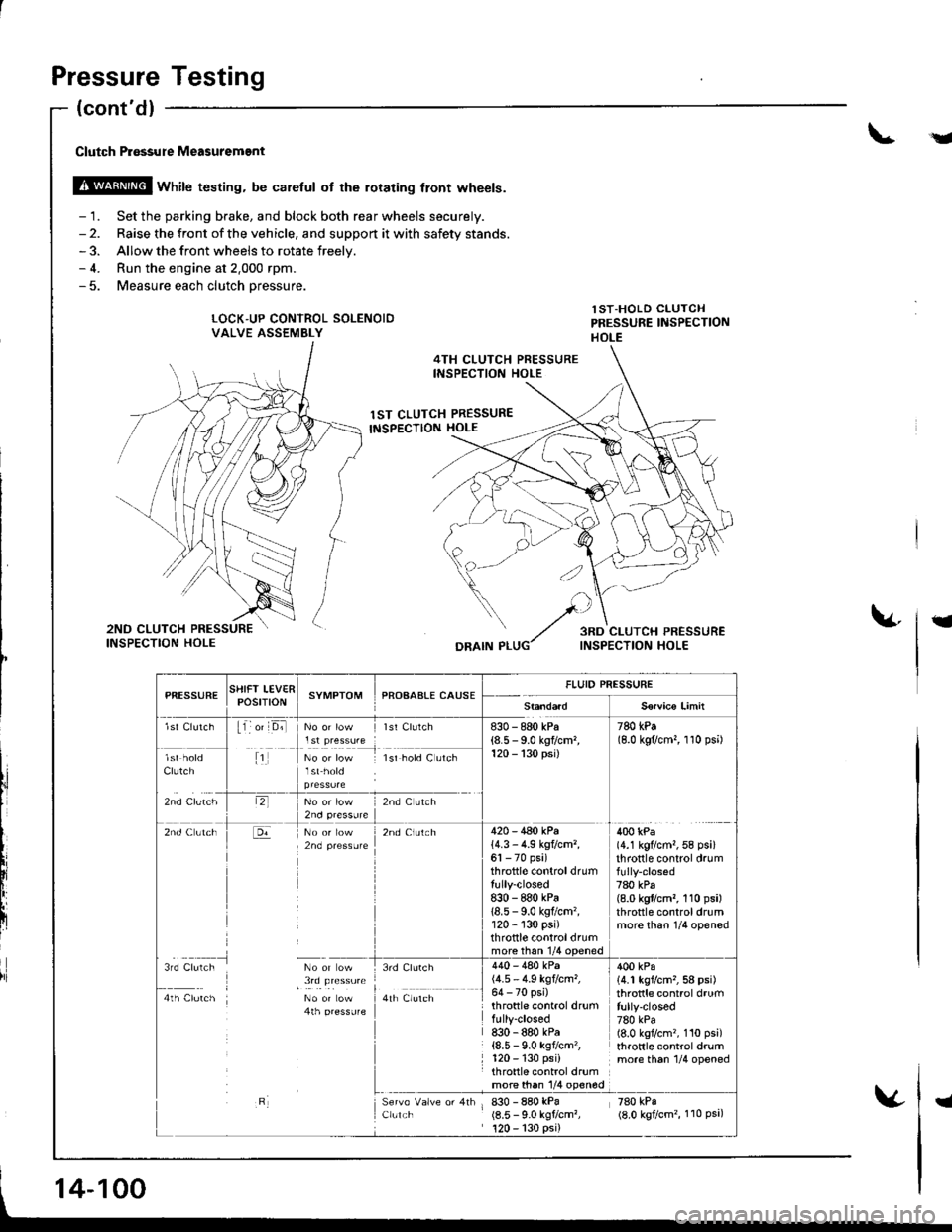
Pressure Testing
.Y
Clutch P.6ssure Measuremgnt
@ wnirc testing. be caretul ot the rorating tront wheels.
- 1. Set the parking brake, and block both rear wheels securely.- 2. Raise the front of the vehicle, and support it with safety stands.- 3. Allow the front wheels to rotate freelv.- 4. Run the engine at 2.000 rpm.- 5. Measure each clutch oressure.
LOCK"UP CONTROL SOLENOIDVALVE ASSEMBLY
lST-HOLD CLUTCHPRESSURE IiISPECTIONHOLE
4TH CLUTCH PRESSUREINSPECTION HOLE
1ST CLUTCH PRESSURE
INSPECTION HOLE
t
DRAIN P
l,i
PfiESSURESTIIFT LEV€RPOStTtONSYMPTOMPROAAALE CAUSEFLUID PRESSURE
S€rvico Limit
lst Clutch11 o' D;llst Clurch830 - 880 kPa(8.5 - 9.0 kgflcm,120 - 130 psi)
780 kPa(8.0 kgflcm,, 1 10 psi)
Clutch
zno cruiltr
1No or low lsr hold C utch
lr,2nd C ltch
2nd Clutch420 - 440 kPa14.3 - 4.9 kg?cm,,61 - 70 psi)throttle controldrumtully-closed8:|0 - 880 kPa18.5 - 9.0 kgflcm'�,120 - 130 psi)throttle controldrummore than 1/4 ooened
400 kPa(4.1 kg?cm,,58 psi)throttle control drum
780 kPa(8.0 kgflcm,, 110 psi)throttle controldrummore than 1/4 opened
3rd Clulch No or ow
I , !,q !le"**4th Clutch No or Low4th pressufe
3rd Clurch
a,r il","r,
Clulch
440 - 480 kPa(4.5 - 4.9 kgtcm,,64 - 70 psi)throttle control drumfully-closed830 - 880 kPa{8.5 - 9.0 ksf/cm'�,120 - 130 psi)throttle control drumrn9l9!q l/4 olqg
830 - 880 kPa(8.5 - 9.0 kgtcm?,120 - 130 psi)
400 kPa14.1 kgvcm,,58 psi)throttle control drumfully-closed780 kPa(8.0 kgflcm'�, 110 psi)throttle control drummore th6n 1/4 opened
zeo rpi(8.0 kgtcm'�, 110 Psa,
14-100
I
Page 519 of 1681
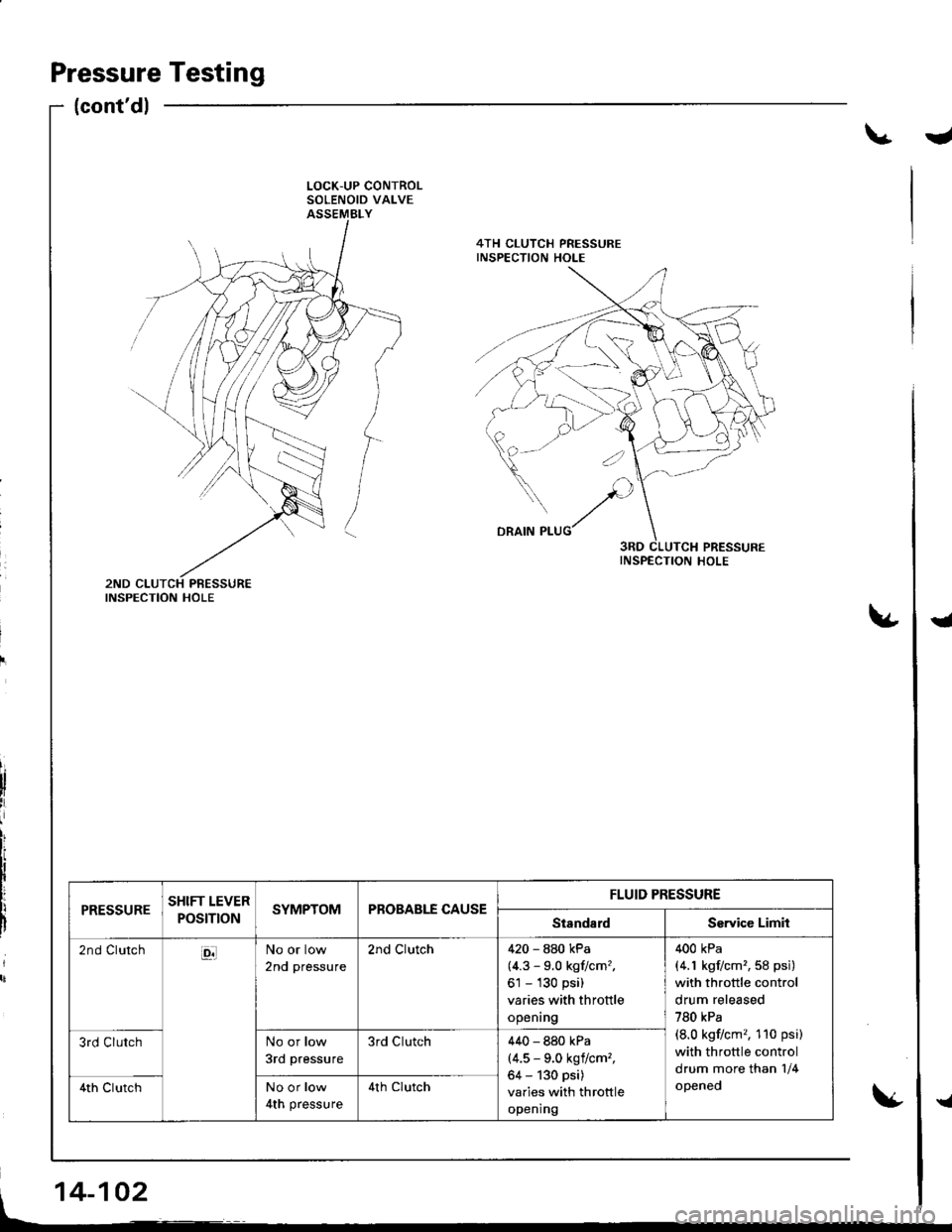
PressureTesting
{
{cont'dl
\. t,
LOCK-UP CONTROLSOLENOID VALVE
4TH CLUTCH PRESSUREINSPECTION HOLE
u
L
INSPECTION HOLE
INSPECTION HOLE
PRESSURESHIFT LEVER
POStTtONSYMPTOMPBOBABLE CAUSEFLUID PRESSURE
SiandardService Limit
2nd ClutchiorNo or low
2nd pressure
2nd Clutch420 - 880 kPa
(4.3 - 9.0 kgf/cm,,
61 - 130 psi)
varies with throttle
openrng
400 kPa(4.1 kgflcm', 58 psi)
with throttle control
drum released
780 kPa
(8.0 kgflcm'�, 110 psi)
with throttle control
drum more than 1/4
openeo
3rd ClutchNo or low
3rd pressure
3rd Clutch440 - 880 kPa
(4.5 - 9.0 kgf/cm,,
64 - 130 psi)
varies with throttle
opening
4th clutchNo or low
4th pressure
4th Clutch
14-102
v
Page 520 of 1681
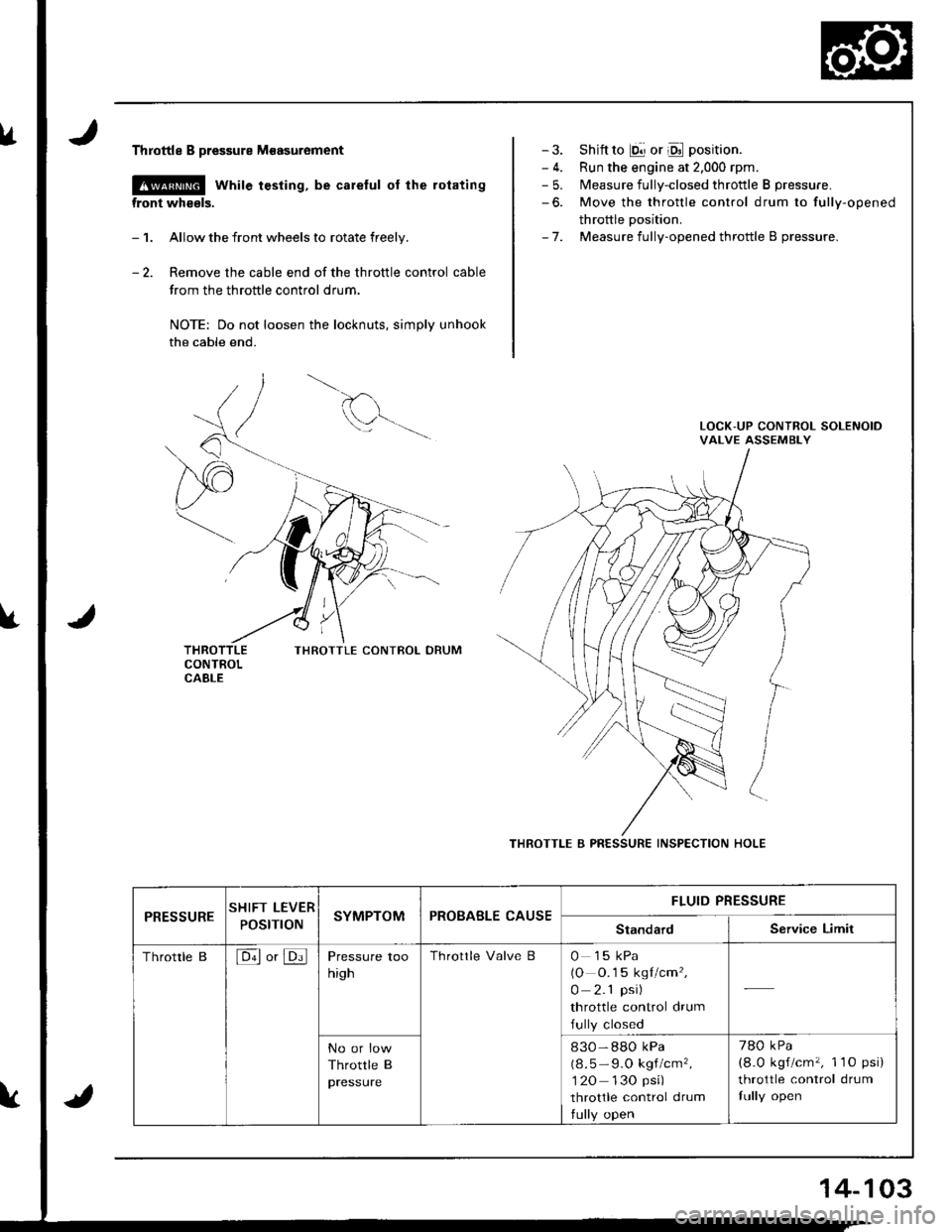
lrThrottle B pressure M€asurement
@ while testing, be careful of the rotating
front wheels.
- 1. Allow the front wheels to rotate freely.
- 2. Remove the cable end of the throttle control cable
trom the throttle control drum.
NOTE: Do not loosen the locknuts, simply unhook
the cable end.
THROTTLE CONIBOL DRUM
- 3. Shift to E!] or Oll position.
- 4. Run the engine at 2.000 rpm.- 5. Measure fully-closed throttle B pressure.
-6. Move the throttle control drum to fully-opened
throttle Dosition.- 7. Measure fully-opened throttle B pressure.
THROTTLE B PRESSURE INSPECTION HOLE
PRESSURESHIFT LEVER
POStnONSYMPTOMPROBABLE CAUSEFLUID PRESSURE
StandardService Limit
Throttle B[6ll or JDi]Pressure too
high
Throttle Valve B0 15 kPa(O O.1 5 kgl/cm',
0 2.1 psi)
throttle control drum
fully closed
No or low
Throttle B
pressure
830-88O kPa
(8.5 - 9.O kgf/cm',
1 20 130 psi)
throttle control drum
tully open
780 kPa
(8.0 kgf/cm'�, 1 1O psi)
throttle control drum
fully open
14-103